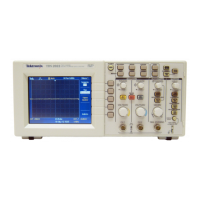Reference
Option Details
HF Reject
Attenuates the high-frequency components above 80 kHz
LF Reject
Blocks the DC component and attenuates the low-frequency
components below 300 kHz
AC Blocks DC components and attenuates signals below 10 Hz
NOTE. Trigger coupling affects only the signal passed to the trigger system. It
does not affect the bandwidth or coupling of the signal displayed on the screen.
Pretrigger. The trigger position is typically set at the horizontal center of the
screen. In this case, you are able to view five divisions of pretrigger information.
Adjusting the Horizontal Position of the waveform allows you to see more or less
pretrigger information.
Video Trigger
Options Settings Comments
Video With Video highlighted, triggering
occurs on an NTSC, PAL, or SECAM
standard video signal
Trigger coupling is preset to AC
Source CH1, CH2, CH3
1
, CH4
1
,
Ext, Ext/5
Selects the input source as the trigger
signal; Ext and Ext/5 selections use
the signal applied to the Ext Trig
connector
Polarity Normal, Inverted Normal triggers on the negative edge
of the sync pulse; Inverted triggers on
the positive edge of the sync pulse
Sync
All Lines, Line Number,
Odd Field, Even Field, All
Fields
Select an appropriate video sync
Use the multipurpose knob to specify
a line number when you select Line
Number for the Sync option
Standard NTSC, PAL/SECAM Select the video standard for sync
and line number count
1
Available only on a 4-channel oscilloscope.
Key Points
Sync Pulses. When you choose Normal Polarity, the trigger always occurs on
negative-going sync pulses. If your video signal has positive-going sync pulses,
use the Inverted Polarity selection.
98 TDS2000C and TDS1000C-EDU Series Oscilloscope User Manual
